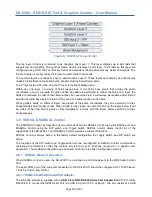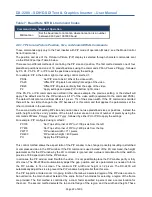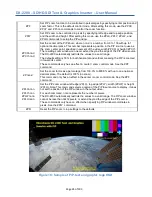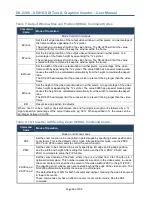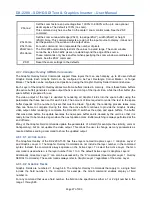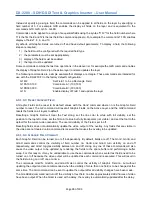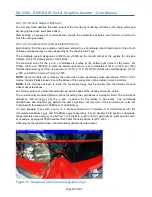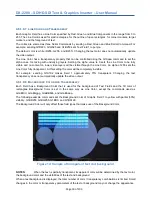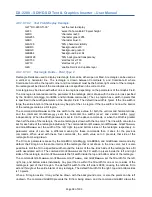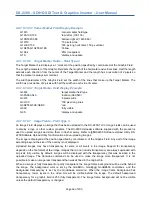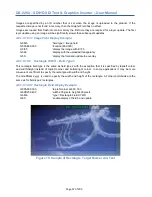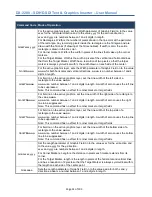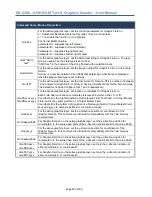
DX-2200
– SD/HD-SDI Text & Graphics Inserter – User Manual
Page 27 of 103
ZSnnn.d
Set the zoom factor as a percentage from 100.0% to 800.0% with up to one optional
decimal place. The default is 100% (no zoom).
This command only has an effect in the center / zoom control mode. See the ZSF
command.
ZSLXnnnn
ZSLYnnnn
ZSLWnnnn
ZSLHnnnn
Set the zoom window left edge (ZSLX), top edge (ZSLY), width (ZSLW) or height
(ZSLH). Note: This command selects a region of the input source to display, it does not
set the position of the window in the output video.
For each command, nnnn represents the number of pixels.
The DX-2200 automatically restricts the values to a valid range. The zoom window
cannot be less than 32x32 pixels, or extend beyond the edge of the source.
These commands only have an effect when specifying the zoom window coordinates in
pixels. See the ZSW command.
ZSR
Reset the zoom settings to the defaults
4.8.1.9 Graphic Overlay SERIAL Commands
The Graphic Overlay Serial Commands support three layers that can each display up to 48 user-defined
Graphic Fields. Each Graphic Field can be configured to be Text, Rectangle, Corner Marker, or Target
Marker. The fields can be configured and positioned using the Graphic Overlay Serial Commands below.
Each Layer of the Graphic Overlay utilizes two frame buffers located in memory. One is these frame buffers
(the active buffer) generates a video output that is mixed on top of the input video, while the other buffer (the
spare buffer) is prepared for use.
The video output of the layer is updated by rendering all Graphic Fields into the spare buffer using the
parameters that have been set for each Field. The amount of time required to render the text to the spare
buffer depends on the number of pixels that must be drawn. Typically, the rendering process takes more
than one frame to complete. During this time, the active buffer continues to provide the Graphic Overlay
video output. After rendering is complete, the DX-2200-TI switches the active and spare buffers. The buffer
that was active before the update becomes the new spare buffer and is cleared by the unit to so that it is
ready for text to be rendered again when the next update occurs. Buffer switching is always performed at the
end of frame.
Many of the Graphic Field commands update the parameters of a Field (for example the visibility, color or
transparency), but do not update the video output. This allows the user to change as many parameters as
required before sending a command to show the updated output.
4.8.1.9.1 A
CTIVE
L
AYER
The Graphics Overlay of the DX-2200-TI-03 has three layers named
Graphics Layer 1
,
Graphics Layer 2
and
Graphics Layer 3
. The Graphic Overlay Commands do not include the layer number in the command
syntax. Instead, the commands always operate on the Active Layer. To select the Active Layer, the GLn
command is used where n is the layer number from 1 to 3. The default Active Layer is Graphics Layer 2.
Additionally,
Graphics Layer 1
can also be accessed by the 'S' commands (See Graphic Layer 1 Overlay
SERIAL Commands). These commands always refer to
Graphic Layer 1
regardless of the Active Layer.
4.8.1.9.2 G
RAPHIC
F
IELDS
Graphic Fields are numbered 1 through 48. The Graphic Overlay Commands that apply to a single field
include the field number in the command, for example, the GnnS command enables display of field
number nn.
For any command that uses a field number, the field can be specified as either a 1 or 2 digit number in the
range 1 through 48.
Summary of Contents for DX-2200
Page 87: ...DX 2200 SD HD SDI Text Graphics Inserter User Manual Page 87 of 103 ...
Page 92: ...DX 2200 SD HD SDI Text Graphics Inserter User Manual Page 92 of 103 ...
Page 97: ...DX 2200 SD HD SDI Text Graphics Inserter User Manual Page 97 of 103 ...
Page 100: ......
Page 101: ......
Page 102: ......
Page 103: ......







